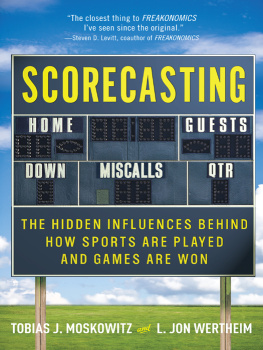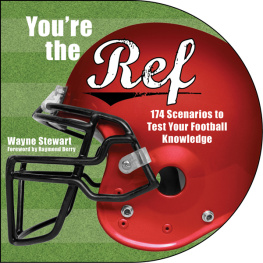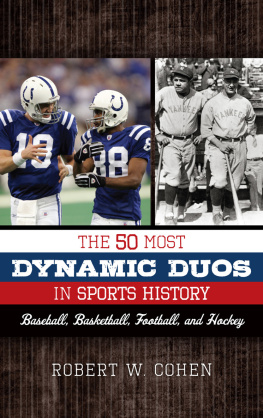
Copyright 2011 by Tobias J. Moskowitz and L. Jon Wertheim
All rights reserved.
Published in the United States by Crown Archetype, an imprint of the Crown Publishing Group, a division of Random House, Inc., New York.
www.crownpublishing.com
Crown Archetype with colophon is a trademark of Random House, Inc.
Library of Congress Cataloging-in-Publication Data
Moskowitz, Tobias J. (Tobias Jacob), 1971Scorecasting: The hidden influences behind how sports are played and games are won / Tobias J. Moskowitz and L. Jon Wertheim.
p. cm.
1. SportsMiscellanea. 2. SportsProblems, exercises, etc.
I. Wertheim, L. Jon. II. Title.
GV707.M665 2011
796dc22
2010035463
eISBN: 978-0-307-59181-4
v3.1
To our wives, to our kids and to our parents for driving us between West Lafayette and Bloomington all those years
CONTENTS

INTRODUCTION

It was the summer of 1984 in Ortonville, Michigan, a lakeside blip on the map somewhere between Detroit and Flint. The second session of Camp Young Judaeaprovince to a few hundred kids from the American heartlandwas under way, and Bunk Seven fielded a formidable softball team.
There was one problem. In keeping with the camps themes of community and democracy and egalitarianism and the like, the rules dictated that every member of the bunk was required to bat and play the field. Although eight members of Bunk Seven ranged from capable to exceptional softball players, the ninth was, in a word, tragic. One poor kid from Iowa whose gangly body resembled a map of Chilewell call him Ari, thus sparing anyone potential embarrassmentwas a thoroughly pleasant bunkmate, armed with a vast repertoire of dirty jokes and a cache of contraband candy. Unfortunately, Ari was sensationally nonathletic. Forget catching a ball. Asking him to drink his bug juice from a straw would mean confronting the outer limits of his physical coordination. Robert Redford was starring in The Natural that summer, and here, on another baseball diamond, was the Unnatural.
Not surprisingly, when Bunk Seven took the field, Ari was dispatched to the hinterlands of right field, on the fringes of the volleyball court, the position where, the conventional thinking went, he was least likely to interface with a batted ball. The games took on a familiar rhythm. Bunk Seven would seize an early lead. Eventually, Ari would come to the plate. He would stand awkwardly, grip the bat improperly, and hit nothing but air molecules with three swings. Glimpsing Aris ineptitude, the opposing team would quickly deduce that he was the weak link. When it was their turn to bat, they would direct every ball to right field. Without fail, balls hit to that area would land over, under, or next to Arianywhere but in the webbing of his borrowed glove. Eventually hed gather the ball and, with all those ungovernable limbs going in opposite directions, make a directionless toss. The other team would score many runs. Bunk Seven would lose.
A few weeks into the summer, the Bunk Seven brain trust seized on an idea: If Ari played catcher instead of right field, he might be less of a liability. On its face, the plan was counterintuitive. With Ari behind home plate, his clumsiness would be on full display, starting with the first pitch, and hed figure prominently in the game, touching the ball on almost every play.
But there was no base stealing allowed, so Aris woeful throwing wasnt a factor. He might drop the odd pop-up, but at least the ball would be in foul territory and the batter wouldnt advance around the bases the way he did when Ari dropped balls in right field. With the eight capable players in the field, Bunk Seven didnt let too many runners reach base. On the rare occasions when a runner might try to score, there was usually sufficient time for the pitcher or first baseman to cover the plate, gently relieving Ari of his dutiessomething that couldnt be done as easily on a ball batted to right field.
There was a more subtle, unforeseen benefit as well. On pitches that werent hit, it took Ari an unholy amount of time to gather the ball and throw it back to the pitcher. This slowed the games pace considerably. The pre-bar-mitzvah-aged attention span being what it is, the opposing team began swinging at bad pitches, if only to bypass the agony of waiting for Ari to retrieve the ball. And Bunk Sevens pitcher started tossing worse pitches as a result.
Ari never perfected the fine art of hitting, and eventually he ran out of contraband Skittles. But once he was positioned behind home plate, Bunk Seven didnt lose another softball game the rest of the summer.

For two members of Bunk Sevena pair of sports-crazed 12-year-olds from Indiana, one named Moskowitz and the other Wertheimthis was instructive. The textbook strategy was to conceal your least competent player in right field and then hope to hell no balls were hit his way. But says who? By challenging the prevailing wisdom and experimenting with an alternative, we were able to improve the team and win more games.
Weve been friends ever since, bound in no small part by a mutual love of sports. Now, a quarter century laterwith one of us a University of Chicago finance professor and the other a writer at Sports Illustrated were trying to confront conventional sports wisdom again. The concepts might be slightly more advanced and the underlying analysis more complex, but in the forthcoming pages of Scorecasting , were essentially replicating what we did on the camp softball field. Is it really preferable to punt on fourth down rather than go for it? To keep feeding the teammate with the hot hand? To try to achieve the highest available spot in the draft? Is there an I in team ? Does defense truly win championships?
As for the sports truisms we accept as articles of faith, whats driving them? We know , for instance, that home teams in sportsin all sports, at any level, at any time in historywin the majority of the games. But is it simply because of rabid crowd support? Or is something else going on? As lifelong Cubs fans, we know all too well that without putting too fine a point on it, our team sucks. But is it simply because the Cubs are unlucky, somehow cursed by the baseball deities and/or an aggrieved goat? Or is there a more rational explanation?
Even though sports are treated as a diversion and ignored by highbrow types, they are imbued with tremendous power to explain human behavior more generally. The notion that sports are a metaphor for life has hardened into a clich. We try to be like Mike, to go for the gold, to just do it, to cross the goal line, to hit the home run.
The inverse is true, too, though. Life, one might say, is a microcosm for sports. Athletes and coaches may perform superhuman feats, but theyre subject to standard rules of human behavior and economics just like the rest of us. Well contend that an NFL coachs decision to punt on fourth down is not unlike a mutual fund managers decision to buy or sell a stock or your decision to order meatloaf rather than the special of the day off a diner menu. Well try to demonstrate that Tiger Woods assesses his putts the same way effective dieters persuade themselves to lose weightand makes the same golfing mistakes you and I do. Well explain how referees decision-making resembles parents deciding whether to vaccinate their kids and why this means that officials dont always follow the rule book. Well find out how we, as fans, view our favorite teams much the same way we look at our retirement portfolios, suffering from the same cognitive biases. As in life, much of what goes on in sports can be explained by incentives, fears, and a desire for approval. You just have to know where to look and it helps if you have data to prove it.
Next page







